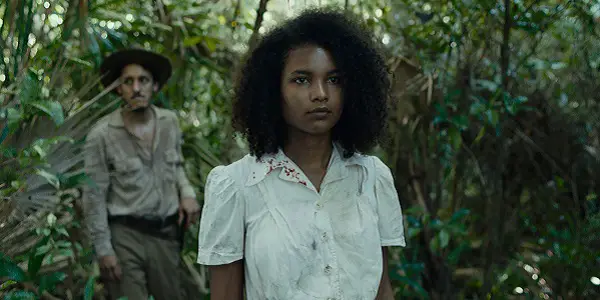“Unfortunate you if you cannot understand the mysteries of the jungle.” It’s hard to imagine a more fitting opening line for Tragic Jungle, the fifth feature from Mexican filmmaker Yulene Olaizola. Set in the early 1920s on the border between Mexico and Belize (then known as British Honduras), the mysterious, myth-laden film chronicles the encounter between a runaway Belizean woman and a group of Mexican gum harvesters deep in the jungle — itself a living, breathing character that looms large and ominous over the film. As the humans clash with the hostile environment and each other, Olaizola weaves together an undeniably feminist film that combines ancient myth with modern critique, with mixed results.
Nature’s Wrath
Agnes (Indira Andrewin) is desperate to escape from the white British landowner who intends to have her for a bride. Together with her older sister and a guide, they escape into the jungle with the sinister landowner hot on their heels. Naturally, tragedy ensues. Agnes appears to survive (the keyword here is “appears”) and is rescued — or rather, taken captive — by a group of Mexican workers who are harvesting gum from the trees in the jungle. A language barrier ensures that an atmosphere of suspicion remains between the workers and Agnes, one that only grows thicker and more suffocating throughout the film.

At first, one of the men declares that anyone who lays a hand on Agnes will suffer the consequences. Yet these men, who have not laid eyes on a woman in a very long time, cannot control their desires for very long. Agnes, a virgin who earlier in the film witnessed her sister having sex with their guide and innocently questioned her about what it was like to be with a man, doesn’t appear to have any qualms about satisfying these men’s needs; if anything, she grows more confident as she becomes fully aware of the power that she holds over these men by virtue of her sexuality. As the film progresses, her wide eyes seem to narrow in barely suppressed laughter, while her mouth starts to turn upward into a devilish smile that seems to imply she knows something that the others do not.
Soon, these men start to encounter more and more misfortune — and those who are meeting unfortunate ends tend to be the ones who have just had sex with Agnes. Is the jungle itself taking revenge on the men for their greedy acts of desire and destruction, or is the girl who appears to be Agnes actually a demon known in Mayan mythology as the Xtabay, who dwells in the forest and lures men to their deaths through seduction? A dreamlike voiceover that runs throughout the film seems to imply the latter, noting, “Those who followed the Xtabay never returned.”
Woman’s Revenge
In Tragic Jungle, Olaizola takes the old myth of Xtabay and filters it through a contemporary feminist lens, highlighting the ways that women are taken advantage of and demonized by men for their sexuality. The film’s greatest weakness is its human characters, which is ironic as its greatest strength is the character of the jungle. The men are too thinly sketched out for one to be terribly invested in their fates; as they slowly but surely get offed in a variety of morbid ways, one doesn’t clap with glee or mourn their loss, but instead merely shrugs.
The character of Agnes is also quite opaque, though one imagines that this is to maintain the layers of mystery that surround her presence among the men, leaving the audience as much in the dark as to her identity as they are. Did Agnes die in the forest with her, allowing her body to be used as a vessel by Xtabay to exact vengeance upon men? Or is she indeed alive, a human girl who is just trying to survive the only way that is accessible to her, and it’s only because of the superstitions and paranoia of the gum harvesters that we think otherwise? The answer remains ambiguous, right through the film’s hallucinatory conclusion.
Meanwhile, the titular jungle is an audiovisual feast that draws you in and refuses to let you go, even when the film feels as though it is dragging on longer than its 96-minute running time. The sound design is a many-layered collage that combines throaty cries of monkeys with the piercing chirps of birds and the harsh scraping of the gum harvesters’ knives against the trunks of the trees. The anachronistic electronic score from composer Alejandro Otaola only adds to the heady brew; the haunting and ethereal sounds of synths somehow seeming entirely fitting for this period piece, both blending with and emphasizing the natural sounds of the jungle.
The wonderful soundtrack is matched by Sofia Oggioni’s lush cinematography, full of saturated color and stark sunlight and shadow, that ensures that you can almost feel the sweat dripping down your own back as you watch the film. Combined, they render this world governed by myth and superstition into something deliciously real, a living thing that is just as dangerous and devious — and much more interesting — as the men in its midst.
Conclusion
There is much to enjoy about Tragic Jungle, but in the end, one is left hungry for something more than what the film actually is.
What do you think? Are you familiar with the legend of Xtabay? Share your thoughts in the comments below.
Tragic Jungle is screening as part of the Main Slate at the 2020 New York Film Festival.
Watch Tragic Jungle
Does content like this matter to you?
Become a Member and support film journalism. Unlock access to all of Film Inquiry`s great articles. Join a community of like-minded readers who are passionate about cinema - get access to our private members Network, give back to independent filmmakers, and more.